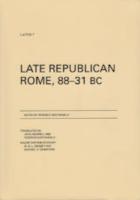
London Association of Classical Teachers (2017) p/b 386pp £18 (ISBN 9780903625418)
Available at: https://lactor.webs.com/
The LACTOR sourcebook series is well-known and loved by school and university teachers alike for its accessibility, thorough coverage and helpful commentary. This particular volume has been long in the making. As S. explains, work on updating the old LACTOR 7, Roman Politics 80-44 BC, was begun in the 1990s by Michael Crawford and John Murrell, who remained valuable consultants when he inherited the project. But S. has extensively restructured it, added much new material and extended the chronological focus with a particular eye to the OCR Ancient History A-level Depth Study, ‘The breakdown of the late Republic, 88-31 BC’. The result is hugely welcome and will be an essential tool for teachers of the late Republic. Indeed, its material on the triumviral period will be useful too for Augustus modules, given that the constraints of space limited its coverage in LACTOR 17, The Age of Augustus.
The book is organised into two main parts. A ‘Narrative’ covers the main period’s political events, bookended by a prologue looking back to 133 BC and an epilogue on the emergence of the principate. A collection of ‘Key Themes’ then expands the scope from high politics into Rome’s relationship with Italy and the wider empire, the imperial economy, law, intellectual life, ‘wives and daughters’ (though why not just ‘women’?) and political culture and practice. Each theme is introduced with a brief and helpful paragraph establishing major concepts and explaining its importance, but the focus and relevance remains primarily political, again in keeping with the OCR Depth Study. This is not a social history to complement the political focus of the narrative, but rather provides a wider context for it.
Compiling a sourcebook is a process of selection, and inevitably any reader will encounter choices which they might have made differently. I was surprised to find nothing on Antony’s funeral speech over Caesar’s body, the proposed amnesty for the tyrannicides or their subsequent flight in the section on the aftermath of the Ides: the latter simply appear in Greece, minting coins. Viewed as a collection, though, this volume is extremely comprehensive and well-balanced. The selections from Cicero will be particularly welcome given the daunting size of his surviving corpus, while S.’s commentaries often note material not itself included within the book, allowing readers to pursue it for themselves. Very sensibly, S. also recaps details and provides cross-references whenever topics crop up across more than one section, to allow for the majority who will read selectively.
Reading the volume as a single, unfolding work, though, is also worthwhile. Despite the fragmentary structure imposed by the sourcebook format, clear and persistent themes develop. Obvious ones include the expediency of political allegiances, the influence of personal networks on individuals’ political stances, and the continuing weight placed on precedent despite the frequency with which it was challenged or overturned. The economic inter-connectedness of the Mediterranean world emerges out of Atticus’ financial management in the 80s BC before being explored more deeply in the thematic sections on ‘Rome and the Empire’ and ‘The Imperial Economy’. S. also very rightly draws attention to the number of occasions on which alternative states of various kinds were established during this period: the Italian alliance during the Social War, Sertorius in Spain, the liberators in Greece or Sextus Pompey on Sicily. Both emulators and rivals of Rome, these examples reveal a great deal about how power was asserted and expressed during this era.
The main sections of the book are supplemented by some useful apparatus. A glossary and introductory notes on the sources will be helpful, although the latter offer no comment on working with the coins and inscriptions which occur throughout the book. Specific source issues are, of course, also regularly discussed in the accompanying commentaries. The appendices are mainly reference lists, covering the consuls for the main period, uses of the senatus consultum ultimum and the tribunician veto, and the format of the Roman calendar. Amongst these, Appendix B on the senatus consultum ultimum is more than the sum of its parts, conveying clearly both the formal requirements for invoking it and the increasing intensity of its usage from 63 BC onwards. The bibliography is a well-selected guide to relevant English-language further reading of an appropriate level. A concordance and indexes of people and places follow, but the absence of any thematic index prevents the reader from looking up themes such as ‘factions’, ‘proscriptions’ or ‘veterans’, despite the fact that they are certainly present in the book.
The book is professionally produced, although the coin images are dark and it is a pity that one or two (including the famous Brutus EID MAR denarius) are presented on a black background. The text contains some typographical errors, which I have emailed to the author for correction in future editions, but I found only one likely to impede understanding: in the commentary to B177d, the first ‘Caesar’ in the phrase ‘Caesar’s willingness to work with some friends of Caesar’ should surely be ‘Cicero’. They do not detract from the value of this timely and well-conceived collection. S. himself, as well as his collaborators and the series editors, should be thanked for their efforts.
Penelope Goodman
